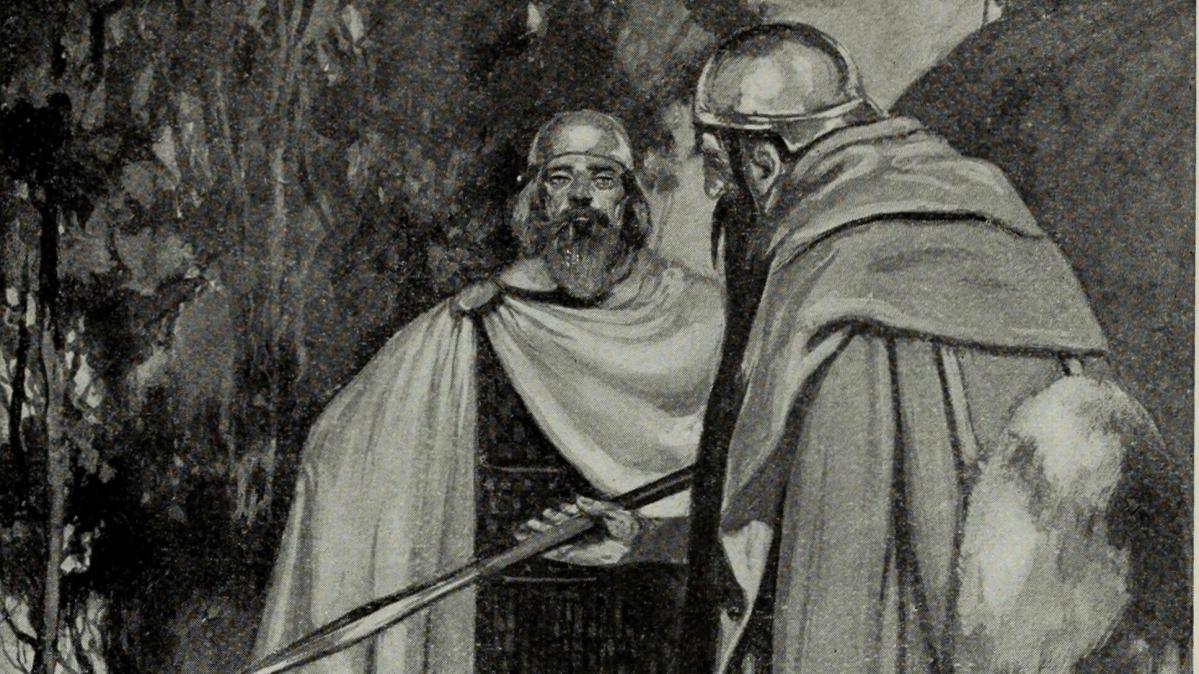Earlier today I reviewed the latest campaign from The Adventure Zone. One of my favorite characters from Graduation was The Firbolg, played by Justin McElroy. The Firbolg had no name and was a member of a forest-dwelling race of creatures able to communicate with nature. He was bluish and large, which makes sense since in Dungeons & Dragons Firbolg are half-giants. In the game, Firbolgs are reclusive and stay mainly with their groups in the forest but are formidable when it comes to magic and some weapons.
Now, I had assumed that like other races in D&D the Firbolg were invented for the game or maybe even based on some generalized fantasy creatures, like orcs. So imagine my surprise when I was reading some Irish mythology and encountered reference to the Firbolg. It turns out the Firbolg are a part of mythic Irish history and may even hint at some incredibly complex real-life occurrences.
Now, before we talk about the Firbolg, we need to talk about Ireland and Irish history in general, specifically pre-Christian Irish history. As we mentioned last week, the Celts, who were the main resident of Ireland when other Europeans came along, had a complex and ancient culture with myths and history passed down in an oral tradition. This means that there aren’t a lot of primary sources for Irish history from certain older eras because nothing was written down. Following the introduction of Christianity and monks who liked to do that whole recording history thing, some ancient Irish myths and legends and epics were recorded.
Now, not all of these records were preserved either but some were adapted and retold and merged and out of that, we get a very important work called the Lebor Gabála Érenn, the “Book of the Takings of the Land of Ireland,” best known as The Book of Invasions. This anonymously compiled text from around the 1000s is fascinating, but to say this book is semi-historical is giving it a lot of credit. However, it contains a lot of mythology that’s foundational to the Celtic canon even if a lot of it has been garbled and Christianized over the centuries.
What The Book of Invasions does is take a whole bunch of myths of Irish gods and heroes and make them into … not Gods. It’s a lot of things including an attempt to Christianize and demystify Celtic myths and also to provide a common history for Ireland. It tells a history of Ireland in a series of six different, yes you guessed it, invasions. Seeing as how the history of Ireland (and Britain, Wales, and Scotland next door and indeed a lot Europe) is a long series of migrations and conquests, this does make some sense. It also does that annoying Christianizing thing by linking parts of ancient Irish myths to the bible.
So, with all of that aside we can get to the Fir Bolg (the name can be one word or two depending, I’m going to use two words of the mythic people and one word for the D&D race for clarity) who are, sorry to tell you, not forest-dwelling giant-kin who like to eat berries and talk to squirrels or something. I’m going to skip over the first two invasions of Ireland and get to a group who came to Ireland led by a guy named Nemed. Nemed only had a few folks on his ships and also Ireland was at that time full of a race called the Fomoire. Now we don’t really know who the Fomoire are or where they came from based on the Book of Invasions. They’re just … there and they are sort of demonic and otherworldly so they are maybe some kind of old god or a previous pantheon sort of like the titans, but I’m just guessing here.
Nemed dies of plague, but his descendants do okay for a while, clearing fields and enjoy lakes springing into existence … until the Fomoire start oppressing them and demanding a tithe of milk grain and children at Samhain. The Nemedians rise up and somehow their numbers have increased so much they muster a force of 60,000! And they beat the Fomoire king Conand (yay!) but they have another king Morc (booo) who defeats them and drives them out of Ireland and some of them go to Greece where they are enslaved for a long time.
Their 300-year enslavement in Greece involved them carrying large bags of dirt around so when they stole some Greek boats and headed back to Ireland, they were called the Fir Bolg: the men of bags, which is honestly not the most intimidating name. So the return of the Fir Bolg to Ireland represents the fourth invasion, and they did pretty well, and even divided the country into the five provinces based on their five kings, into which it is still divided.
But what about the Fomoire? The Fir Bolg seem to get along with them fine, and things are chill until the next invasion by the Tuatha Dé Danann. Also known as the Tuatha Dé these were very much the actual gods and goddesses of Ireland, placed in a different context and form. The Book of Invasions tried to make them not gods, and other interpretations have demoted them to fairies, but … they are gods.
The invasion of the Tuatha Dé launched an extremely complicated war between them and the Fomoire, but the Fir Bolg were on the side of the Fomoire. This is why they tend to get a bad rap … think, the humans fighting on the side of Mordor in Lord of the Rings (seriously, Tolkien was inspired by this stuff including the big bad Fomoire king Balor, who has one giant eye!).
The Fir Bolg king does manage to cut off the arm of the Tuatha Dé king, Nuada, but they still don’t do very well in this war. The Fir Bolg were maybe driven from Ireland or just eventually inner-married with the Tuatha Dé, as many Fomoire did. And everyone eventually calmed down in time for the next invasion by the actual ancestors of the people of Ireland. Except not because the whole thing is a giant mess because these people are also the first invasion and … yeah, the Christianization is confusing.
So, back to the Fir Bolg in myth. They were people in this huge myth cycle but were they … real? Well, who knows. Ireland is old. Very old and indeed was settled by a different wave of people. Just this week, scientists announced evidence from a butchered reindeer bone that puts humans in Ireland 33,000 years ago, and that’s 20,000 years earlier than was previously thought. People were building megaliths in Ireland around 3,500 BCE but the Celts didn’t arrive until maybe 500 BCE in the Bronze age.
It’s possible the Fir Bolg were people who resided in Ireland before the Celts got there because we do have some record of Fir Bolg names. Or they were one wave of Celtic people. Some suggest the name Fir Bolg is related to the Belgae, a group of tribes from Gaul and what is now Belgium who at one point invaded Ireland. But we don’t know for sure at all.
And now the Firbolg are part of a fantasy roleplaying game, adding one more layer to history. And who knows if someone centuries from now will be looking at the Dungeons & Dragons Fifth edition manual with the same frustration and confusion we feel at the Book of Invasions, which they knew what the “real” story of it all was.
(image: Fir Bolg and Tuath Dé meeting before the Battle of Moytura. Stephen Reid in T. W. Rolleston’s Myths & Legends of the Celtic Race, 1911, Wikimedia Commons/Internet Archive)
Want more stories like this? Become a subscriber and support the site!
—The Mary Sue has a strict comment policy that forbids, but is not limited to, personal insults toward anyone, hate speech, and trolling.—









